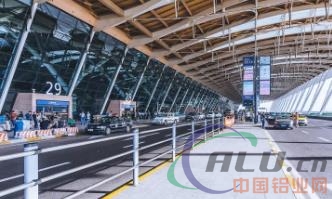[China Aluminum Network] Advantages of aluminum-manganese-alloy-enveloped sheets: Aluminum is widely used as exterior walls and roofing in the construction industry. The choice of aluminum as a building material is determined by its economy, practicality, and aesthetic value. • Airports, high-speed rail stations, sports venues, and stylish homes, etc., only use aluminum to highlight the individuality of the building.

1. Light weight: The weight of the lower structure is light, and the prefabricated component can be placed in a high place. Without using a large lifting device, the lifting work can be easily performed on the spot.
2. Corrosion resistance: The aluminum material itself has a strong corrosion resistance, and this feature is more prominent after being pre-treated, so that even if the thin aluminum sheet is formed under extreme conditions for a long period of time, it does not have to be expensive. For maintenance.
3. Rugged and Durable: The aluminum material has incredible strength and can be used to create a light but exceptionally stable structure.
4. Strong plasticity: Aluminum material has good flexibility and plasticity, and unlimited design potential. It can be a variety of processing, such as: shaping, welding, riveting and cutting into a dynamic 3-D geometry.
5. Lapping easy: In addition to the more commonly used connection methods in the construction industry, methods such as welding, riveting, fixing, and direct fixing can also be used. These methods are simple and convenient, and can quickly and safely complete the construction components. Connection work.
6. Recyclable: Usually only one process can be used to recover aluminum roofing and wall panels. The recycling process saves 95% of energy compared to the primary production process.
7. Aesthetic value: It can be surface-polished and painted, such as anodized or coated, to meet the architect's high aesthetic requirements and to extend the potential life of aluminum materials.
Second, aluminum manganese stand-up system features:
1; No mouth, no screw holes, complete appearance of the building
2; bendable into inner arc and outer arc
3; can choose different materials and colors
4; overall structural waterproof and drainage functions
5; can be used for roofs with a slope as small as 1.5°
6; excellent wind pressure performance (with the bottom plate), especially for typhoons, stormy areas
7; can eliminate the pressure generated by thermal expansion and contraction
8; Simple and fast machine winding, easy construction and economy
9; easy to lay insulation and sound-absorbing layer
10; No need for chemical caulking, eliminating pollution and aging problems
Additives for construction are a chemical compound that has a small share of cement and concrete but can significantly improve certain properties of concrete.
They only need to be blended in cement and concrete, which can generally reduce the amount of water added; improve the strength and durability of concrete; change the flowability of concrete and increase its operability; and save building materials and reduce engineering costs. .
The variety of additives is sensitive and the functions are different. However, there are mainly: water reducing agents, air entraining agents (AE agents, air entraining agents), retarders , accelerators , early strength agents, antifreeze agents , expansion agents, water repellents, anti-cracking agents, and composite additives.
(1) Water reducing agent is a kind of Surfactant , which has many branches of molecular structure, short molecular group of hydrophobic group and strong polarity. Divided into common reducer and superplasticizer. The ordinary water reducing agent refers to an admixture having a general water reducing enhancement effect while maintaining the consistency of the concrete. Main ingredients: lignosulfonate, alkali lignin, sodium sulfonate humate, etc. Superplasticizer refers to an additive that has a significant water-reducing effect under the condition that the consistency of the concrete is constant. The main components are: methylnaphthalenesulfonate, naphthalenesulfonate, polynaphthalenesulfonate, β-naphthalenesulfonic acid formaldehyde condensate sodium salt, Gumalon-indene resin, sulfonated melamine formaldehyde resin, etc.
(2) Air entraining agent refers to an admixture capable of introducing a large amount of finely distributed fine bubbles in concrete to reduce the segregation of concrete, improve workability, and significantly improve the durability against frost. Main ingredients: rosin soap, rosin hot polymer, sodium alkyl sulfonate, sodium alkylbenzene sulfonate, linear alkyl sulfonate, lauryl sulfate, protein material, higher fatty alcohol derivative, AE minus Aqueous agent, sulfonated alkyl succinate, and the like.
(3) Early strength agent is an additive that can improve the early strength of concrete and has no significant effect on the late strength. Can be applied to projects under a variety of temperature conditions. Main components: chloride, thiosulfate, calcium chloride, ferric chloride, magnesium chloride and other chlorides, alcohol amines, Potassium Hydroxide, sodium hydroxide, formic acid and methyl salt, carbonate, aluminum cement, Sintered alum and so on.
Additives For Building Material
water reducing agents, air entraining agents, retarders, accelerators , Building Material additives , antifreeze agents
Jinan Huijinchuan Chemical Industry Co., Ltd. , https://www.hjcchemical.com